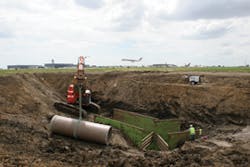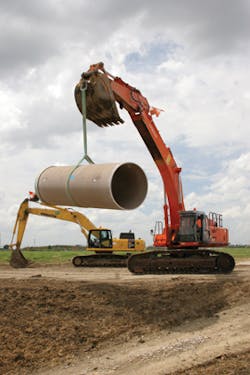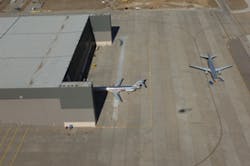Back in the late 2000s, the city of Portland, ME, faced a situation that is not uncommon for a Northeastern municipality: separating sewage and stormwater flows, and replacing very old infrastructure in the process. The $4 million West Side Interceptor combined sewer overflow abatement project replaced 100-year-old 24- and 30-inch-diameter vitrified clay line with 60-inch-diameter, high-performance polypropylene pipe. Additionally, the project created a parallel 10-foot-diameter line that now solely conveys stormwater. The overall project objective was to increase conveyance capacity, eliminate combined sewer overflows (CSOs) at Capisic Pond Dam, and prevent untreated wastewater from flowing into the Fore River Estuary.
The need to replace old, deteriorated pipe—or pipe that has failed in emergency situations—is something that public works managers across the country are increasingly facing. A wide range of pipe materials and installation techniques are available for significantly improving situations like Portland’s over the long term.
The Portland project started June 2010 and had to be completed in five months. The Maine Department of Inland Fisheries and Wildlife and the Department of Environmental Protection identified the Capisic Pond area as an inland wading waterfowl habitat and limited disturbance of soil for the pipeline to a start of no earlier than August 1 and ending no later than October 15. The overall project started a little earlier, in June.
Dave Senus, P.E., civil service project manager for the project’s consulting engineer, Woodard & Curran in Portland, points out that the pipe material options were based upon project-specific stormwater conveyance analyses conducted in the area from 2004 to 2005 and 2007 to 2008. The analyses indicated what size pipe would be needed considering factors associated with pipe hydraulics such as slope and roughness coefficients.
The critical requirements were that the selected pipe provided a watertight joint and met the city’s pipe stiffness standard of 46 pii. The options with which Woodard & Curran provided the city were ADS SaniTite HP pipe; epoxy-coated reinforced concrete (RCP); and centrifugally cast glass fiber reinforced polymer pipe.
The SaniTite HP pipe that was ultimately chosen has a triple-wall construction designed to provide a smooth interior and exterior wall design and is supported by a corrugated structural core for improved stiffness and greater beam strength to minimize deflection and enhance long-term performance. SaniTite HP 30-inch to 60-inch (750- to 1,500-millimeter)-diameter pipe meets ASTM F2764 and is also watertight, exceeding the requirements of ASTM D3212 with dual gaskets and banded reinforced bell and spigots.
Woodard & Curran determined that a 60-inch-diameter pipe was needed to handle the peak flow rate anticipated for the system of 70 million gallons a day along its 1-mile length. The ADS pipe, with a Manning roughness coefficient value of 0.012, met this requirement.
“We actually bid the project allowing for several pipe alternatives,” he recalls. “However, when we got to the range of size we were looking at—this was a 60-inch-diameter conveyance sewer, and we were looking at replacing 24- and 30-inch pipe up to 60-inch—you start to lose options in the pipe world. It made certain options less attractive.” Woodard & Curran met with ADS representatives, who showed the engineers how the pipe was manufactured and how the gasket ends of the pipe fit together. The pipe also underwent third-party testing to verify the stiffness, Senus says.
“We looked at the smoothness factor, the rigidity of the pipe, and the fact that we had installation of almost 20 feet down to as little as only several feet of cover–3 feet.” The pipe met the criteria for shallow cover.
Installation was a challenge for R. J. Grondin & Sons Inc. of Gorham, ME. The contractor followed the path of the old clay pipe; the last half of the project was through a park with a wetlands complex and ecological features. There, installation was limited to a 30-foot-wide travel corridor, and the depth was as much as 22 feet. Due to the presence of Maine bedrock, blasting was also required.
“The attractive part for the contractor was that the ADS pipe is relatively light,” says Senus. “The ability to work with lighter-weight pipe that went together easily certainly helped expedite the process.”
Sanitary manholes were fabricated at the ADS factory using the 60-inch SaniTite HP pipe with a 48-inch riser. Once in place, each manhole was encapsulated in concrete with a field-placed steel-reinforcing cage. Each of the 21 structures was individually designed for an H-20 load rating and fill heights. The project utilized about 5,600 feet of 60-inch SaniTite HP and another 200 feet of ADS SaniTite HP in diameters ranging from 24 to 48 inches for laterals connected to the main trunk using Inserta Tee fittings and fabricated fittings. The fittings provided a method of watertight lateral service connection for wastewater and stormwater pipe systems. “Being able to install ample connections in line with the pipe and provide structural support around the riser allowed the contractor to work quickly and with minimal issues relative to their bypass flow regime,” says Senus.
The pipe lengths were placed in 20-foot lengths; installing 8-foot pipe lengths would have required three times as many trucks, Ken Grondin of R. J. Grondin & Sons points out. Existing native soil was primarily used to backfill the trench. Crushed stone was placed beneath the pipe, and about 1 foot of cover was placed directly over the top the pipe.
By October 2010, the project was complete, after just five months of construction. Grondin conducted a Mandrel test for pipe deflection several months later, and the pipe maintained its shape regardless of the depth. The Mandrel test is standard operating procedure for a pipeline system to determine the degree of deflection, if any, due to installation.
The Maine Chamber of the American Public Works Association (APWA) awarded the city first place for this project in its Public Works Excellence Competition.
Senus concludes that lightweight pipe that still meets stiffness requirements can keep projects like this on a fast track. “In talking with the contractor through the process, they were very happy with the results,” he says. “They were able to move forward quickly and get it done with the restrictions put on the project by the permits.”
Emergency Airport Repair
Airports are harsh construction environments in many ways. North Texas Contracting of Keller, TX, has discovered a new aspect of this reality, which impacted the choice of pipe material for a couple of challenging drainage projects at the Dallas/Fort Worth International Airport (DFW).
One project was a $700,000 emergency repair to an 84-inch corrugated culvert that had failed after heavy rains in 2007 and created a sinkhole that was about 35 feet deep and 40 feet in diameter—and located near DFW’s major runway. North Texas Contracting had to work around the clock with 41 days of nonstop double-shift work to complete the job as quickly as possible.
The North Texas Contracting crew located the damaged section of pipe and replaced it with a 20-foot section of 84-inch-
fiberglass reinforced, polymer mortar pipe
for an emergency 84-inch corrugated culvert
repair and a hangar drainage modification.
diameter Hobas centrifugal cast, fiberglass reinforced, polymer mortar (CCFRPM) pipe. The Hobas pipe was selected for its ease of installation owing to its low length-to-weight ratio. This project represented the first fiberglass pipe ever installed at DFW Airport.
Zach Fusilier, vice president at North Texas Contracting, recalls that the company had to build a blast wall to allow planes to take off next to the excavation. The joint was plugged into the steel corrugated line on one side and collared into the concrete junction box on the other side. The work area was shored for safe ingress and egress using an engineered double trench box system, which allowed a safe work environment while repairs were made.
The emergency repair went so well that North Texas Contracting is also using Hobas pipe for the $9 million DFW Hangar Drainage Modifications project, which was begun in 2007 and completed in late 2008. For the 13,000-foot system of pipe–being installed along with oil/water separators, a substantial lift station, and two retention ponds in hangar areas–7,600 feet of Hobas CCFRPM pipe was used.
The new system, jointly designed by CH2M Hill and A.N.A. Consultants of Fort Worth, TX, was installed alongside hangars at DFW. The outflow line feeds the retention ponds, which provide a diversion area for any contaminants far away from the Trinity River Authority wastewater system in the event of an oil leak, accidental fuel discharge, or aqueous film forming foams (fire suppression) release. In an emergency that would trigger a foam discharge, the system would automatically divert the flow away from the oil/water separator and into the retention ponds. North Texas Contracting installed 18- through 54-inch Hobas pipe at four hangars, each of which has a separate tie-in to the closed water system. Contaminants that drain into the floor will flow into the new lines and the oil/water separators.
The work on this project was very difficult, too, Fusilier reports. The lines are located up to 25 feet underneath 18 inches of concrete runway pavement at the American Airlines hangar, for example. “It’s very difficult to work around the planes at that depth, under that depth of concrete, all the while being under very tight security,” he says. “You’re required to work as close as 10 feet away from the jets while following all the strict rules and very stringent inspections that come along with working at DFW.”
To maintain traffic in and out of the hangars, CT&S Inc. of Irving, TX, designed and fabricated 1-1/4-inch-thick steel trench plates with 10-inch-tall W-beams to span 6-foot-wide trenches. The plates were engineered to support the 125-ton weight of a fully loaded Boeing 777 that routinely bridged the storm sewer trenches daily, a requirement based on the path of the drainage system.
Crews worked around the clock to complete emergency airport repairs.
As the Hobas pipe was positioned and joined, the trench was backfilled with crushed concrete and native backfill and capped with an 18-inch-thick, 1,500-psi flowable fill grout mix. The grout eliminated the potential for settlement below the apron pavement, which was then reconstructed with another layer of 5,500-psi paving mix according to stringent Federal Aviation Administration requirements.
These projects were not the contractor’s first use of the Hobas CCFRPM pipe. “On large-diameter or deeper pipelines, our firm does prefer fiberglass material because it’s easier to lift,” says Fusilier. “It’s lighter, easier to move, easier to install, and you can modify the lengths in the field—those are all things that make it easier and more efficient to install. When smaller equipment can lay larger pipe, it is an obviously advantageous situation for any contractor.”
Fusilier identifies another reason why the chosen pipe material suited the airport projects. “The airport used Hobas based on its ability to be watertight as a gravity system,” he points out. “Pressure pipe is watertight, obviously, because it’s pressurized, but Hobas used a special nitrile gasket that wouldn’t allow jet fuel to seep in from any existing contaminated soil. The jet fuel–resistant gaskets provided an environmental advantage over those that would otherwise be used on shorter joints on a different pipe material.
“From a design standpoint, the jet fuel-resistant gaskets creating a single watertight system with regard to gravity type was challenging; Hobas was able to provide that for DFW,” Fusilier concludes. “From an installation standpoint, the more joints you have, the more chances you have of a leak, but the longer the joint, the fewer the chances of leaks. That was a big deal for us when looking at concrete pipe alternatives that traditionally utilize 8-foot joints. Hobas was a noncorrosive, airtight, watertight system, which proved to be why the airport specified it.”
Saving a Highway, Protecting an Ocean
In 2012, a severely deteriorated storm drainpipe under the Pacific Coast Highway 1 in Malibu, CA, was threatening to cause a pavement collapse and shut down traffic flow on the main thoroughfare. DownStream Services Inc. of Escondido, CA, employed a trenchless application of Reline America’s Ultra-Violet (UV)-Cured Glass Fiber-Reinforced (GFR) Pipe Liner to turn the situation around in a little over two months and extend the life of the pipe for many years.
In early January, the California Department of Transportation (Caltrans) contacted DownStream Services and reported that a 24-inch corrugated metal pipe (CMP) that stretched underneath both lanes of the highway and a restaurant before emptying into the ocean was severely deteriorated. Victor Roberts, vice president at DownStream Services, recalls just how bad the situation was.
“CMP is subject to rocks and everything rolling down the pipe and chipping off the galvanization, and as sand goes through, it sandblasts off the galvanization, exposing the bare metal,” says Roberts. “What happens is that the invert, the bottom of the pipe, rusts out. Probably 60% of the pipe was rusted out with large voids that were 4 feet deep in some areas.
“One of our technicians did a confined space entry and crawled about 30 or 40 feet down the pipe, because the closed circuit television camera could not travel any farther due to the voids. He was able to drop his feet down in the void, turn around, come out forward, which is pretty amazing for a 24-inch pipe. These large voids probably went for 100 feet. In years past, they butted two culverts together to form a new culvert. The oldest pipe was starting to implode on itself, and the two transitions weren’t meeting.”
To address the sinkholes, DownStream Services used several cubic yards of concrete to fill the voids underneath the existing pipe. A day later, crews began work on the liner. DownStream Services ordered the Blue-Tek UV-Cured liner in late January, the liner arrived in mid-February, and installation was complete by around the third week in February.
The relining technique that DownStream Services used was from Reline America, whose system suits pipes from 6 to 52 inches in diameter. The application is environmentally friendly and incorporates installation techniques that do not require jobsite mixing of chemicals or excavation.
After an initial cleaning and visual inspection, a slip sheet is inserted into the pipeline. The impregnated, spirally wound, seamless fiberglass liner is inserted using a constant tension winch. Impregnation of the fiberglass with the resin is performed to the customer’s specifications at the Reline America factory in Saltville, VA. An outer film is inserted to contain potential styrene emissions and protect the liner from contaminants and protrusions. Packers and roller guides are inserted, and the liner is inflated with a blower. A UV light train is inserted into the liner to initiate the curing process, which is continuously digitally recorded. Once the curing process complete, the light train and inner film are removed from the line, and precision cuts are made to the liner before it is put into service.
The fiberglass resin has a very high abrasion resistance and, because the liner forms such a smooth-bore interior surface, sand does not get stuck in the pipe pits and tumbling rocks do not chip it. Roberts says he expects the liner to last for 50 years.
Durability aside, structural integrity is not a concern, Roberts says. “It has a 1.5 million-pound tensile strength, which is super, super high—it’s five times higher than a normal CIP [cured-in-place] pipe liner,” he says. “Caltrans likes it for that reason. A pipe like this sometimes has only 2 feet of cover and has semis running over it. It has to resist the load and the forces put on it by heavy, heavy truck traffic.”
Caltrans had no other choice, Roberts contends. “The alternative other than a pipe liner is to dig and replace, which is not really an option for Caltrans. Highway 1, the main thoroughfare between Ventura County and Los Angeles County, is very, very busy, and dig and replace would have taken a couple of weeks more and cost many times more than a pipe liner. This was probably 15% of the cost of digging and replacing. There was also the impact on the traffic. They couldn’t do [dig and replace]—they really couldn’t.”
Yet another benefit of the lining system is an increase in the pipe flow capacity. “Corrugated metal pipe has a very high Manning roughness coefficient,” points out Roberts. “Water will go through it at only about 12 feet per second at the fastest. This liner, by the time it was done, we estimated 28 feet per second—so it doubled the capacity.”
Installation went well, Roberts concludes. “There were a lot of angle points and bends, so the challenges were very difficult. But the thing that this project taught us is how flexible the product is. That’s good, because this was probably the worst pipe we’ve ever fixed.
“Now everything is going out the ocean. This is Malibu; in a community like this, the most important thing to avoid is contamination of the ocean.”
Increasing Flow Capacity in the Mountains
Since 2008, the Vermont Agency of Transportation (VAOT) has addressed the deterioration of stormwater pipe by sliplining about 10,000 linear feet of large-diameter, 40-year-old culverts with 60- to 128-inch-diameter liners under Interstates 89 and 91. The new corrugated metal culvert liners have fill heights ranging from 40 to more than 100 feet. Two projects in this region in particular demonstrate how VAOT has improved both headwater depth and flow capacity, and the long-term viability of the stormwater infrastructure.
Three high-density polyethylene (HDPE) pipes, 12-inch for I-89 Exit 2 and 10-inch at I-89 and Quimby Mountain Road, were placed at the invert of the existing host pipe to convey the stream base flow and serve as a slipline construction platform. These new HDPE pipes, kept in place between the host pipe and the liner pipe, will allow for a future bypass system in case a liner repair is ever required.
At I-89 and the Exit 2 crossing—a project completed over an eight-week stretch in early 2008—the two mainlines of I-89 crossed the northbound exit ramp and southbound entrance ramp for Exit 2. The existing structure was a 152-inch rise by 138-inch span vertical ellipse steel plate on a 3.9% grade. This 578-foot structure had minor wear at the invert, and a 128-inch-diameter Aluminized Steel Type 2 (A2) corrugated steel pipe in 10-gage thickness with 5-inch-by-1-inch corrugations was used to improve it.
This was the largest round pipe that could be pushed through the extreme fill areas—the worst-case clearance areas—of the
Reline America’s UV-cured pipe liner (left) was used to replace severely deteriorated storm drainpipe under the Pacific Coast Highway.
highway due to deflection of the existing plate pipes. Internal bands with fiberglass insulation were used to connect existing pipe lengths and minimize grout infiltration during the grouting process. For this staged grouting operation, three 16-foot pipe lengths typically were pushed through, and intermediate bulkheads were constructed every 48 feet to isolate each compartment. Floor jacks used during the grouting operation ensured that the invert of the new liner pipe closely matched the invert of the existing culvert. The new headwalls at the inlet of each structure are designed to improve the entrance coefficient, minimize undermining by the mountain brooks, and retain the highway embankment.
At I-89 and the Quimby Mountain Road Crossing—a project completed in about six weeks, after Exit 2 was complete—an existing 114-inch rise by 103-inch span vertical ellipse steel plate crossed under I-89. This culvert is on a steep 8.2% grade and experiences high bed loading from mountain runoff. Additionally, an existing six-degree elbow is located one-third of the way from the outlet. The engineers opted to line this structure with 500 linear feet of 96-inch-diameter Contech Engineered Solutions Corlix 10-gage aluminum pipe with 3-by-1-inch corrugations. They selected this material for its superior abrasion resistance and its deep corrugations to help reduce flow velocity.
Barry Ward, superintendent for Morrill Construction Corporation in North Haverhill, NH, notes that making the improvements in this region in the spring created a number of challenges. “Being in a mountainous region, the water comes up very fast and you have to keep an eye on it,” he says. “The high flows subside quickly, but they come quickly, too. If you know you’ve got a storm coming, you’ve got to make sure everything’s cured, because you can’t possibly pump out the amount of water that will flow through the pipe.”
The method of sliplining used in these projects is expected to provide these large culverts under deep fills with an additional 75 to 100 years of service life.
Ward concludes that no real alternatives to the bypasses existed. “There was such a large volume of water flow that we would have had to rent a couple of 8-inch pumps, which were very expensive. We had to have some way of conveying water from one end of the interstate to the other during construction.”






